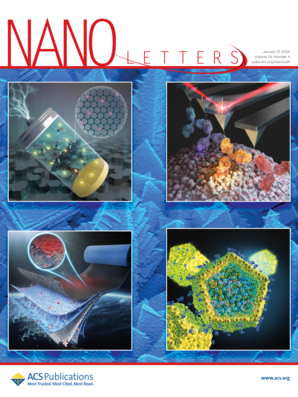Measurement and Modeling of Electron and Hole Injection Dynamics in Quantum-Dot Light-Emitting Diodes: Quantifying Temperature-Dependent Charge Imbalance.
IF 9.6
1区 材料科学
Q1 CHEMISTRY, MULTIDISCIPLINARY
引用次数: 0
Abstract
The development of quantum-dot light-emitting diodes (QLEDs) has been hindered by an incomplete understanding of their charge injection dynamics. This study systematically investigates electron-hole injection in red, green, and blue QLEDs using electrically pumped transient absorption and time-resolved electroluminescence technologies. Temperature-dependent measurements between 140 and 298 K reveal weak electron injection enhancement versus strong hole injection improvement as temperature increases. Therefore, lower temperatures exacerbate charge imbalance, increasing electron accumulation in quantum dots during the operation. We develop quantitative models using space-charge-limited current and thermionic emission theories for electron and hole injection, respectively, establishing a universal framework for QLED operation. These findings provide critical insights for optimizing the charge balance and device performance in QLEDs.量子点发光二极管中电子和空穴注入动力学的测量和建模:量化温度相关电荷不平衡。
量子点发光二极管(qled)的发展一直受到对其电荷注入动力学不完全理解的阻碍。本研究利用电泵瞬态吸收和时间分辨电致发光技术系统地研究了红、绿、蓝qled的电子空穴注入。在140 ~ 298 K之间的温度相关测量表明,随着温度的升高,弱电子注入增强,而强空穴注入增强。因此,较低的温度加剧了电荷不平衡,增加了量子点在运行过程中的电子积累。我们分别利用空间电荷限制电流和热离子发射理论建立了电子和空穴注入的定量模型,建立了QLED运行的通用框架。这些发现为优化qled中的电荷平衡和器件性能提供了重要的见解。
本文章由计算机程序翻译,如有差异,请以英文原文为准。
求助全文
约1分钟内获得全文
求助全文
来源期刊

Nano Letters
工程技术-材料科学:综合
CiteScore
16.80
自引率
2.80%
发文量
1182
审稿时长
1.4 months
期刊介绍:
Nano Letters serves as a dynamic platform for promptly disseminating original results in fundamental, applied, and emerging research across all facets of nanoscience and nanotechnology. A pivotal criterion for inclusion within Nano Letters is the convergence of at least two different areas or disciplines, ensuring a rich interdisciplinary scope. The journal is dedicated to fostering exploration in diverse areas, including:
- Experimental and theoretical findings on physical, chemical, and biological phenomena at the nanoscale
- Synthesis, characterization, and processing of organic, inorganic, polymer, and hybrid nanomaterials through physical, chemical, and biological methodologies
- Modeling and simulation of synthetic, assembly, and interaction processes
- Realization of integrated nanostructures and nano-engineered devices exhibiting advanced performance
- Applications of nanoscale materials in living and environmental systems
Nano Letters is committed to advancing and showcasing groundbreaking research that intersects various domains, fostering innovation and collaboration in the ever-evolving field of nanoscience and nanotechnology.
 求助内容:
求助内容: 应助结果提醒方式:
应助结果提醒方式:


